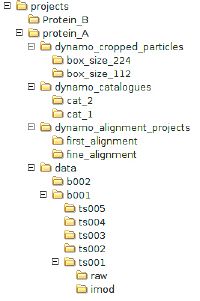Practical Suggestions for Tomographic Reconstruction
This article contains some practical suggestions and examples for the pre-processing of tomographic tilt series and the reconstruction of tomograms. Be aware that there exist many other working strategies and softwares in addition to the examples shown here.
Contents
Naming convention and organizing data
When dealing with large and growing datasets, we highly recommend to strictly follow a consistent file naming convention. A proposed convention is to use a number for the batch (a batch stands for one data acquisition session) and a number for the tilt series within this batch. E.g., the tilt series 21 of batch 1 would be named b001ts021.st. The same goes for all other related file types such as b001ts021.rec, b001ts021.fid and so on. We also recommend to organize all your data in a comprehensive and systematic way from the very beginning. One possible way of organizing your data is shown in the figure below. See more details on tips for management of tomographic data sets.
Drift correction
Any software for drift correction should give good results. A wrapper for motioncor2 can be found in the TomographyTools.
Exposure filtering
If needed, the exposure filtering can be done independently from the drift correction using the function found in TomographyTools.
Example of a pre-processing script
The pre-processing script from the TomographyTools takes the original 4k movies (TS31_000_0.0.mrc, …) and does the drift correction, the exposure filtering and the merging of the drift corrected movies into tilt series. The outputs are an exposure filtered stack (e.g., b001ts031.mrc) and an unfiltered stack (e.g., b001ts31_UW.mrc) that can be used later for CTF estimation.
Tilt series alignment
See considerations for tilt series alignment with IMOD.
Tilt angle convention
We recommend to check that the tilt angle convention is correct in the tilt angle files. How and why this is done is explained here.
CTF estimation
The CTF is ideally estimated on the drift corrected stack (but not exposure filtered and not aligned). A matlab wrapper for ctffind4 can be found in TomographyTools. If the CTF is estimated outside of the IMOD pipeline, the “Run Ctf Plotter” button from IMOD has to be skipped and the results from ctffind4 are used instead. The output from ctffind4 needs to be converted first into a file format that can be read by IMOD with the function found in TomographyTools. Once you created the .defocus file, you can continue in IMOD and click the button “correct CTF”.
Tomogram thickness
When defining the thickness of the tomogram consider these points.
Post processing in IMOD
In the post processing step in IMOD make sure that you swap the y and z dimensions and do not select “convert to bytes” in order to make the tomogram compatible with Dynamo. Also make sure to keep all the IMOD files, in particular the .fid and .com files. This will be useful in cases where tomograms have to be reprocessed.
Assessing tomogram quality
After having computed the final tomogram, we recommend to visually check the tomogram quality as explained here.
NovaCTF
If novaCTF is used for the tomogram reconstruction and CTF correction, the wrapper found in TomographyTools can be used.
